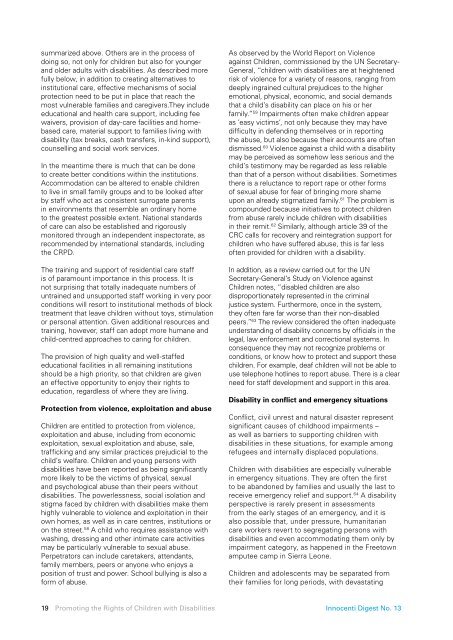Promoting the Rights of Children with Disabilities, UNICEF
Promoting the Rights of Children with Disabilities, UNICEF
Promoting the Rights of Children with Disabilities, UNICEF
- No tags were found...
Create successful ePaper yourself
Turn your PDF publications into a flip-book with our unique Google optimized e-Paper software.
summarized above. O<strong>the</strong>rs are in <strong>the</strong> process <strong>of</strong>doing so, not only for children but also for youngerand older adults <strong>with</strong> disabilities. As described morefully below, in addition to creating alternatives toinstitutional care, effective mechanisms <strong>of</strong> socialprotection need to be put in place that reach <strong>the</strong>most vulnerable families and caregivers.They includeeducational and health care support, including feewaivers, provision <strong>of</strong> day-care facilities and homebasedcare, material support to families living <strong>with</strong>disability (tax breaks, cash transfers, in-kind support),counselling and social work services.In <strong>the</strong> meantime <strong>the</strong>re is much that can be doneto create better conditions <strong>with</strong>in <strong>the</strong> institutions.Accommodation can be altered to enable childrento live in small family groups and to be looked afterby staff who act as consistent surrogate parentsin environments that resemble an ordinary hometo <strong>the</strong> greatest possible extent. National standards<strong>of</strong> care can also be established and rigorouslymonitored through an independent inspectorate, asrecommended by international standards, including<strong>the</strong> CRPD.The training and support <strong>of</strong> residential care staffis <strong>of</strong> paramount importance in this process. It isnot surprising that totally inadequate numbers <strong>of</strong>untrained and unsupported staff working in very poorconditions will resort to institutional methods <strong>of</strong> blocktreatment that leave children <strong>with</strong>out toys, stimulationor personal attention. Given additional resources andtraining, however, staff can adopt more humane andchild-centred approaches to caring for children.The provision <strong>of</strong> high quality and well-staffededucational facilities in all remaining institutionsshould be a high priority, so that children are givenan effective opportunity to enjoy <strong>the</strong>ir rights toeducation, regardless <strong>of</strong> where <strong>the</strong>y are living.Protection from violence, exploitation and abuse<strong>Children</strong> are entitled to protection from violence,exploitation and abuse, including from economicexploitation, sexual exploitation and abuse, sale,trafficking and any similar practices prejudicial to <strong>the</strong>child’s welfare. <strong>Children</strong> and young persons <strong>with</strong>disabilities have been reported as being significantlymore likely to be <strong>the</strong> victims <strong>of</strong> physical, sexualand psychological abuse than <strong>the</strong>ir peers <strong>with</strong>outdisabilities. The powerlessness, social isolation andstigma faced by children <strong>with</strong> disabilities make <strong>the</strong>mhighly vulnerable to violence and exploitation in <strong>the</strong>irown homes, as well as in care centres, institutions oron <strong>the</strong> street. 58 A child who requires assistance <strong>with</strong>washing, dressing and o<strong>the</strong>r intimate care activitiesmay be particularly vulnerable to sexual abuse.Perpetrators can include caretakers, attendants,family members, peers or anyone who enjoys aposition <strong>of</strong> trust and power. School bullying is also aform <strong>of</strong> abuse.As observed by <strong>the</strong> World Report on Violenceagainst <strong>Children</strong>, commissioned by <strong>the</strong> UN Secretary-General, “children <strong>with</strong> disabilities are at heightenedrisk <strong>of</strong> violence for a variety <strong>of</strong> reasons, ranging fromdeeply ingrained cultural prejudices to <strong>the</strong> higheremotional, physical, economic, and social demandsthat a child’s disability can place on his or herfamily.” 59 Impairments <strong>of</strong>ten make children appearas ’easy victims’, not only because <strong>the</strong>y may havedifficulty in defending <strong>the</strong>mselves or in reporting<strong>the</strong> abuse, but also because <strong>the</strong>ir accounts are <strong>of</strong>tendismissed. 60 Violence against a child <strong>with</strong> a disabilitymay be perceived as somehow less serious and <strong>the</strong>child’s testimony may be regarded as less reliablethan that <strong>of</strong> a person <strong>with</strong>out disabilities. Sometimes<strong>the</strong>re is a reluctance to report rape or o<strong>the</strong>r forms<strong>of</strong> sexual abuse for fear <strong>of</strong> bringing more shameupon an already stigmatized family. 61 The problem iscompounded because initiatives to protect childrenfrom abuse rarely include children <strong>with</strong> disabilitiesin <strong>the</strong>ir remit. 62 Similarly, although article 39 <strong>of</strong> <strong>the</strong>CRC calls for recovery and reintegration support forchildren who have suffered abuse, this is far less<strong>of</strong>ten provided for children <strong>with</strong> a disability.In addition, as a review carried out for <strong>the</strong> UNSecretary-General’s Study on Violence against<strong>Children</strong> notes, “disabled children are alsodisproportionately represented in <strong>the</strong> criminaljustice system. Fur<strong>the</strong>rmore, once in <strong>the</strong> system,<strong>the</strong>y <strong>of</strong>ten fare far worse than <strong>the</strong>ir non-disabledpeers.” 63 The review considered <strong>the</strong> <strong>of</strong>ten inadequateunderstanding <strong>of</strong> disability concerns by <strong>of</strong>ficials in <strong>the</strong>legal, law enforcement and correctional systems. Inconsequence <strong>the</strong>y may not recognize problems orconditions, or know how to protect and support <strong>the</strong>sechildren. For example, deaf children will not be able touse telephone hotlines to report abuse. There is a clearneed for staff development and support in this area.Disability in conflict and emergency situationsConflict, civil unrest and natural disaster representsignificant causes <strong>of</strong> childhood impairments –as well as barriers to supporting children <strong>with</strong>disabilities in <strong>the</strong>se situations, for example amongrefugees and internally displaced populations.<strong>Children</strong> <strong>with</strong> disabilities are especially vulnerablein emergency situations. They are <strong>of</strong>ten <strong>the</strong> firstto be abandoned by families and usually <strong>the</strong> last toreceive emergency relief and support. 64 A disabilityperspective is rarely present in assessmentsfrom <strong>the</strong> early stages <strong>of</strong> an emergency, and it isalso possible that, under pressure, humanitariancare workers revert to segregating persons <strong>with</strong>disabilities and even accommodating <strong>the</strong>m only byimpairment category, as happened in <strong>the</strong> Freetownamputee camp in Sierra Leone.<strong>Children</strong> and adolescents may be separated from<strong>the</strong>ir families for long periods, <strong>with</strong> devastating19 <strong>Promoting</strong> <strong>the</strong> <strong>Rights</strong> <strong>of</strong> <strong>Children</strong> <strong>with</strong> <strong>Disabilities</strong> Innocenti Digest No. 13
















